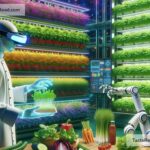The Future of Food: Building a Resilient System for Tomorrow
Food is a basic human need. Without it, life cannot exist. But the way we grow, produce, and consume food today is facing many challenges. Climate change, population growth, and global events like pandemics are putting stress on the systems that provide our food. To ensure everyone has enough to eat, now and in the future, we need to rethink how food works in our world. This involves increasing systemic resilience—making the food system strong enough to adapt to challenges.
What is Systemic Resilience?
Systemic resilience means creating systems that can handle problems without breaking down. In the case of food, it’s about ensuring that everyone can access safe, nutritious, and affordable food—even when the world is unstable. A resilient food system can cope with various disruptions, like extreme weather events, supply chain issues, and disease outbreaks, while continuing to function effectively.
Why Our Current Food System Is Struggling
The modern food system has given us many benefits, such as more food than ever before. Farmers use advanced technology and methods to grow crops that feed billions. But this system also has weaknesses:
-
Climate Change: Rising temperatures, droughts, floods, and unpredictable weather make it harder to grow food consistently in many regions.
-
Dependency on a Few Crops: A large portion of the world’s food comes from just a few plants like rice, wheat, and corn. If these crops are hit by disease or fail due to extreme weather, millions could go hungry.
-
Global Supply Chains: Many countries rely on imported food. If trade is disrupted—as it was during the COVID-19 pandemic—food prices go up, and shortages can occur.
-
Waste: About one-third of all food produced worldwide goes to waste. This is a missed opportunity to feed people and protect resources.
-
Overuse of Resources: Agriculture uses huge amounts of land, water, and energy, often in unsustainable ways. This damages ecosystems and threatens long-term food security.
How Can We Make Food Systems More Resilient?
To create a food system that can endure and thrive in the future, changes are needed. Here are some steps to make food more resilient and sustainable:
1. Diversify Food Sources
Relying on a small number of crops is risky. Encouraging the growth of a wider variety of plants and animals can spread risk and increase resilience. For example, farmers could plant more hardy crops such as quinoa, millet, or sorghum—these are resistant to harsh climates and provide important nutrients.
2. Embrace Local Farming
Locally grown food is less dependent on long supply chains and is usually fresher. Urban farming, community gardens, and regenerative agriculture techniques can make neighborhoods more self-reliant, especially in times of crisis.
3. Innovate with Technology
Cutting-edge technologies can improve farming efficiency and reduce waste. For example, precision agriculture uses sensors and drones to help farmers determine the exact amount of water or fertilizer their crops need. Vertical farming grows plants in stacked layers using less space and water, which can be vital in urban areas.
4. Reduce Food Waste
We must find better ways to use food that would otherwise be thrown away. Restaurants, supermarkets, and households can donate surplus food to feeding programs or turn scraps into compost to enrich soil.
5. Adapt to Climate Change
Farmers can be supported with policies and tools to help them adapt to new climate challenges. For instance, drought-resistant seed varieties and better irrigation systems can improve productivity even in harsh conditions.
6. Strengthen Supply Chains
More efficient and flexible supply chains, using technology like blockchain, can help track food from farms to stores with fewer disruptions. Governments can also create emergency food reserves to guard against major crises.
7. Invest in Alternative Proteins
Meat production uses significant resources and contributes to greenhouse gas emissions. Alternatives like plant-based proteins, lab-grown meat, and insect-based food are eco-friendly options that can expand food choices while reducing the environmental impact.
The Role of Individuals
While governments, businesses, and farmers play a major role in shaping the future of food, individuals also have a part to play. Simple actions like eating locally, reducing food waste, and trying new, sustainable foods can make a difference. By making mindful choices, we can support a more resilient system.
The Future of Food Is Collaborative
The future of food is not just about science and technology—it’s about collaboration. Farmers, scientists, policymakers, businesses, and consumers need to work together to create a resilient and sustainable food system. Policies and investments must focus on long-term solutions rather than short-term profits. Encouraging innovation and making food systems fairer for everyone will help prepare for the challenges ahead.
A Vision of Tomorrow’s Plate
Imagine a future where everyone has access to healthy, affordable food—whether you live in a city, a countryside village, or a remote island. Farms use renewable energy to grow crops without wrecking the environment. Food no longer goes to waste, and communities share the bounty of local farms. Global supply chains are reliable, but local food options are abundant. People enjoy meals made from resilient crops and low-impact protein alternatives.
This future is possible if we act now to strengthen the food system. By investing in systemic resilience, we can ensure that the plates of tomorrow are full—no matter what challenges the world faces. Together, we can build a future of food that is sustainable, adaptable, and able to feed generations to come.


